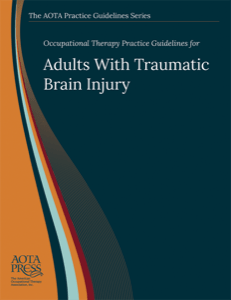Abstract
An individual in the United States sustains a TBI approximately every 23 seconds, and more than 25% of OTs have reported working with clients with TBI. Interrelated physical, cognitive, psychiatric, and emotional effects can influence a client’s capacities, activities, relationships, and roles for months and years after the injury. Advancements in medical care and prevention programs related to TBI have greatly improved in recent years, and the annual death rate has declined. This decrease, however, has led to a dramatic increase in the prevalence of people living with chronic symptoms of TBI.
This Practice Guideline provides an overview of the evidence for occupational therapy to assist people with TBI in achieving health, well-being, and participation in life through engagement in occupations. It includes a description of the occupational therapy process for this population, defining the domain and describing interventions that occur within acceptable occupational therapy practice. Extensive attention is given to issues with arousal and alertness and cognitive, motor, visual, and psychosocial impairments. Appendixes include selected ICD-10 and CPT codes and searchable evidence tables.
Details
Table of Contents
Occupational Therapy Practice Guidelines for Adults With Traumatic Brain Injury
-
Front Matter
11

- 1. Overview of Traumatic Brain Injury 122
- 2. Best Practice and Summaries of Evidence 526
- 3. Interventions That Address Arousal and Alertness 728
- 4. Interventions That Address Motor Impairments 930
- 5. Interventions That Address Cognitive Impairments 1132
- 6. Interventions That Address Vision and Visual−Perceptual Impairments 1334
- 7. Interventions That Address Psychosocial, Behavioral, or Emotional Impairments 1536
- 8. Interventions That Address Everyday Activities and Areas of Occupation and Social Participation 1940
- 9. Implications of the Evidence for Occupational Therapy Practice, Education, and Research 2344
- References 2950
-
Appendix A. Preparation and Qualifications of Occupational Therapists and Occupational Therapy Assistants
4970

- Appendix B. Domain and Process of Occupational Therapy 5172
- Appendix C. Occupational Therapy Process for Adults With TBI 5576
- Appendix D. Selected ICD–10 Codes 87108
- Appendix E. Selected CPT® Codes for Occupational Therapy Evaluations and Interventions for Adults With TBI 89110
- Appendix F. Constraint-Induced Movement Therapy and Adjunctive Interventions 93114
- Appendix G. Evidence-Based Practice 97118
-
Appendix H. Evidence Tables and Risk-of-Bias Tables
101122

